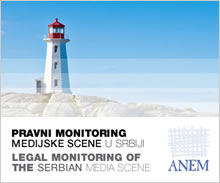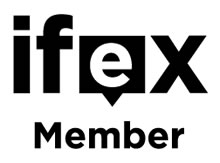Home
/
Media Scene
/
News Archive until September 2011
27. 01. 2006
LOWER FEES FOR BROADCASTERS
BELGRADE, January 27, 2006 – The announcement of the public competition for the issuing of national frequencies and program broadcasting in Belgrade and Vojvodina region was accompanied with the reactions of the professional associations objecting to the payment rates proposed for the program broadcasting. While the Association of Professional Broadcasters of Serbia (APRES) claimed the “television rates were more or less realistic”, the Association of Independent Electronic Media expressed concern over the destiny of commercial radio and television stations due to extremely high fees. Although the members of the Broadcast Agency Council claimed they would not issue any comment during the competition which might upset the procedure, the Council Deputy Chairman Aleksandar Vasic said the objections to the payment rates were not entirely reasonable. ANEM recently stated that “the competition for broadcast license issuing had not been adequately prepared, although there was enough time for that”, emphasizing the problem which could be created by the set high rates, approved by the Serbian Government. The association also stated the rates were even ten times higher than those in other countries in the region. “Representatives of all media associations had a chance to object at the meetings held in the Broadcast Agency, when the price list for program broadcasting was proposed. What ANEM is claiming now is only partly true, since we talk about two different models of payment. For example, according to the model in Croatia, the fee is indeed lower than in Serbia, but Croatian broadcasters pay another type of VAT, that is, 0.54 percent of their total gross income paid to the state as concession. According to Croatian laws, the frequency is regarded as state’s concession. The similar case is in Macedonia as well”, said Vasic. Vasic also said the Broadcast Act in Serbia provided that the broadcasting fee included technical costs and costs of the regulatory body, i.e. the Broadcast Agency, while the surplus went directly to the national budget. “Article 34 of the Broadcast Act provides these funds to be used for the cultural development, education and health”, Vasic added. Vasic noted that, under the Act, Radio Television Serbia was not required to pay the use of frequency as a public service broadcaster, which was financed by the TV subscription paid by the citizens. In light of this, Vasic concluded, the public service broadcaster also had a limited advertising space. One day after the official announcement of the public competition, the Chairman of the Broadcast Council Nenad Cekic revealed the possibility that the broadcasting fees might have been lower than those envisaged by the Agency and adopted by the Serbian Government last week. According to Cekic, the initiative would be launched to amend the provisions of the Broadcast Act, which envisaged that the broadcasters pay one fifth of the price proposed for TV stations for the license for broadcasting, and technical licenses for transmitters. Cekic confirmed that the fees were too high, “since the radio stations participate only 4 percent in the total turnover of advertising revenues”. However, according to the chief editor of the magazine Satelit TV Dragutin Markovic, TV stations that did not get the broadcast license in the competition, or, on the other hand, thought the license was too expensive, they would have the option of airing their program via satellite instead of using the frequency. This way, all users of cable system or satellite dishes would become potential viewers of those television stations’ programs, and all current terrestrial channels will practically become satellite-cable channels. “Every owner of the cable system will be obliged to have a valid contract with the owner of the program or TV station whose program he re-broadcasts, regardless of whether those programs are free of charge or are paid for. The Broadcast Agency will have to request from all cable operators a list of all TV stations in their offer, as well as the copies of the contracts made with those media outlets”, said Markovic. Markovic also noted that the biggest cable operators in Serbia relied on this option of broadcasting program of so-called “small television stations”. “Serbian Broadband” and Telecom will soon launch their digital packages via satellite which will, among other things, enable them to offer to TV stations their already rented transponder on the satellite. This will give those stations a chance to get in the package with the option to broadcast on eight to ten channels. This way, small TV stations will be viewed by all users of satellite antennas or cable TV subscribers. Hypothetically speaking, this way, TV Galaksija could get hundreds of thousand viewers”, Markovic said.
-
No comments on this topic.





